Business Environment Analysis: Primark's Strategies and Policies
VerifiedAdded on 2020/01/28
|18
|6360
|419
Report
AI Summary
This report provides a comprehensive analysis of Primark's business environment, examining the internal and external factors influencing its operations. It begins with an introduction to the concept of the business environment and its impact on Primark, a leading retail enterprise in the UK. The report then delves into Primark's organizational structure and purpose, followed by an assessment of how Primark meets the objectives of its various stakeholders, including customers, suppliers, and investors. Furthermore, the report analyzes Primark's social, employee, customer, and environmental responsibilities. The report also explores distinct types of economic systems, including planned, open market, and socialist market economies, and assesses the impact of fiscal and monetary policies on Primark's operations. Additionally, it examines pricing and output decisions in different market types, the impact of market forces on the organization, and the influence of business and cultural environments. The report concludes with an analysis of the significance of international trade, the impact of global factors on the UK organization, and the influence of European Union policies on Primark.

Business Environment
Paraphrase This Document
Need a fresh take? Get an instant paraphrase of this document with our AI Paraphraser

TABLE OF CONTENTS
INTRODUCTION...........................................................................................................................3
TASK 1............................................................................................................................................3
1.1 Organisations and purpose...............................................................................................3
1.2 Extent to which PRIMARK meets the objectives of different stakeholders....................4
1.3 Responsibility of Primark and strategies to meet them....................................................5
TASK 2............................................................................................................................................6
2.1 Distinct type of economic systems...................................................................................6
2.2 Assessment of Fiscal and Monetary policy......................................................................7
2.3 Different competition policies in the UK.........................................................................7
TASK 3............................................................................................................................................8
3.1 Pricing and output decisions in different types of market................................................8
3.2 Impact of market forces on organisation..........................................................................9
3.3 Business and cultural environments shaping the behaviour of organisation..................11
TASK 4..........................................................................................................................................11
4.1 Significance of international trade..................................................................................11
4.2 Analysis of impact of global factors on the UK organisation........................................12
4.3 Impact of policies of the European Union on the UK business organisation.................14
CONCLUSION .............................................................................................................................15
REFERENCES..............................................................................................................................16
INTRODUCTION...........................................................................................................................3
TASK 1............................................................................................................................................3
1.1 Organisations and purpose...............................................................................................3
1.2 Extent to which PRIMARK meets the objectives of different stakeholders....................4
1.3 Responsibility of Primark and strategies to meet them....................................................5
TASK 2............................................................................................................................................6
2.1 Distinct type of economic systems...................................................................................6
2.2 Assessment of Fiscal and Monetary policy......................................................................7
2.3 Different competition policies in the UK.........................................................................7
TASK 3............................................................................................................................................8
3.1 Pricing and output decisions in different types of market................................................8
3.2 Impact of market forces on organisation..........................................................................9
3.3 Business and cultural environments shaping the behaviour of organisation..................11
TASK 4..........................................................................................................................................11
4.1 Significance of international trade..................................................................................11
4.2 Analysis of impact of global factors on the UK organisation........................................12
4.3 Impact of policies of the European Union on the UK business organisation.................14
CONCLUSION .............................................................................................................................15
REFERENCES..............................................................................................................................16
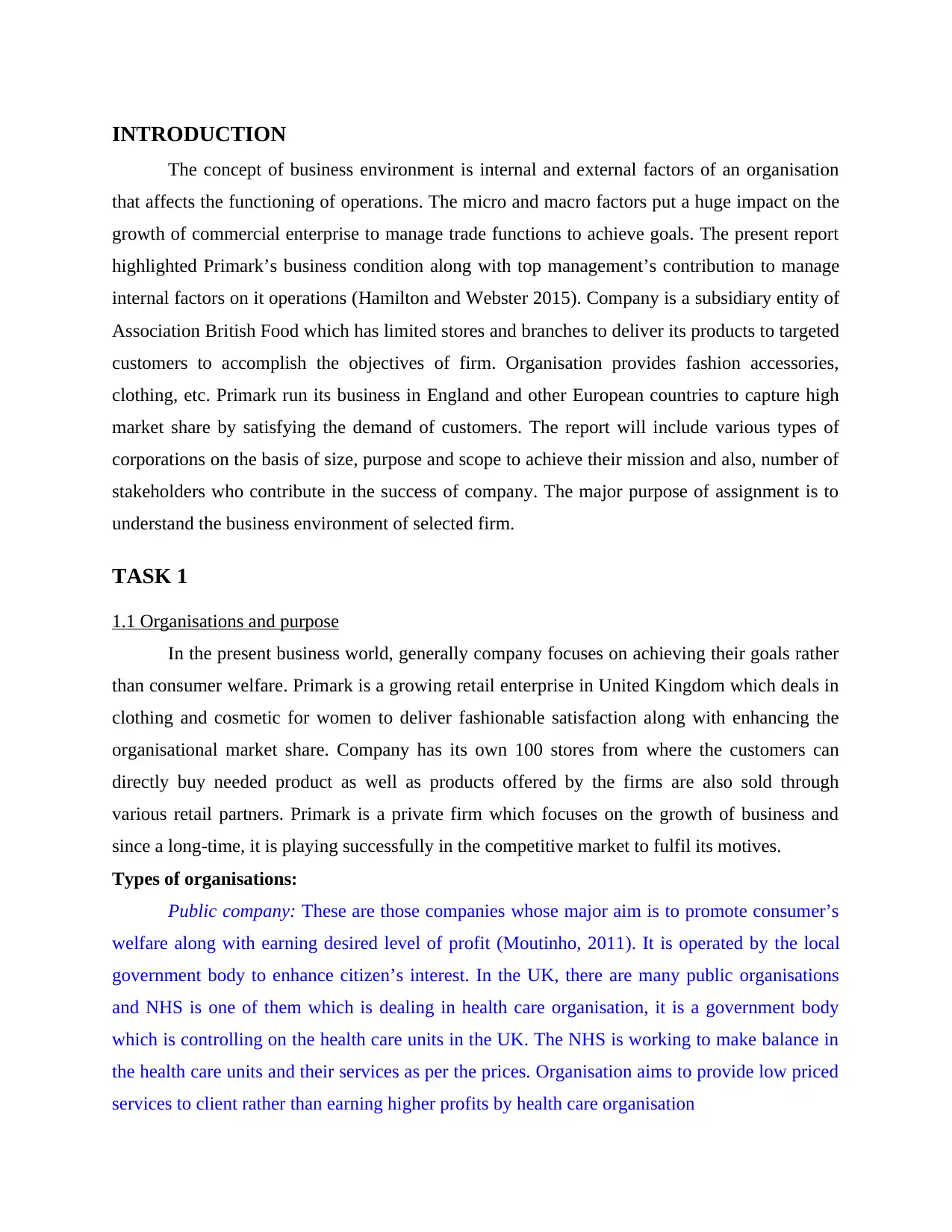
INTRODUCTION
The concept of business environment is internal and external factors of an organisation
that affects the functioning of operations. The micro and macro factors put a huge impact on the
growth of commercial enterprise to manage trade functions to achieve goals. The present report
highlighted Primark’s business condition along with top management’s contribution to manage
internal factors on it operations (Hamilton and Webster 2015). Company is a subsidiary entity of
Association British Food which has limited stores and branches to deliver its products to targeted
customers to accomplish the objectives of firm. Organisation provides fashion accessories,
clothing, etc. Primark run its business in England and other European countries to capture high
market share by satisfying the demand of customers. The report will include various types of
corporations on the basis of size, purpose and scope to achieve their mission and also, number of
stakeholders who contribute in the success of company. The major purpose of assignment is to
understand the business environment of selected firm.
TASK 1
1.1 Organisations and purpose
In the present business world, generally company focuses on achieving their goals rather
than consumer welfare. Primark is a growing retail enterprise in United Kingdom which deals in
clothing and cosmetic for women to deliver fashionable satisfaction along with enhancing the
organisational market share. Company has its own 100 stores from where the customers can
directly buy needed product as well as products offered by the firms are also sold through
various retail partners. Primark is a private firm which focuses on the growth of business and
since a long-time, it is playing successfully in the competitive market to fulfil its motives.
Types of organisations:
Public company: These are those companies whose major aim is to promote consumer’s
welfare along with earning desired level of profit (Moutinho, 2011). It is operated by the local
government body to enhance citizen’s interest. In the UK, there are many public organisations
and NHS is one of them which is dealing in health care organisation, it is a government body
which is controlling on the health care units in the UK. The NHS is working to make balance in
the health care units and their services as per the prices. Organisation aims to provide low priced
services to client rather than earning higher profits by health care organisation
The concept of business environment is internal and external factors of an organisation
that affects the functioning of operations. The micro and macro factors put a huge impact on the
growth of commercial enterprise to manage trade functions to achieve goals. The present report
highlighted Primark’s business condition along with top management’s contribution to manage
internal factors on it operations (Hamilton and Webster 2015). Company is a subsidiary entity of
Association British Food which has limited stores and branches to deliver its products to targeted
customers to accomplish the objectives of firm. Organisation provides fashion accessories,
clothing, etc. Primark run its business in England and other European countries to capture high
market share by satisfying the demand of customers. The report will include various types of
corporations on the basis of size, purpose and scope to achieve their mission and also, number of
stakeholders who contribute in the success of company. The major purpose of assignment is to
understand the business environment of selected firm.
TASK 1
1.1 Organisations and purpose
In the present business world, generally company focuses on achieving their goals rather
than consumer welfare. Primark is a growing retail enterprise in United Kingdom which deals in
clothing and cosmetic for women to deliver fashionable satisfaction along with enhancing the
organisational market share. Company has its own 100 stores from where the customers can
directly buy needed product as well as products offered by the firms are also sold through
various retail partners. Primark is a private firm which focuses on the growth of business and
since a long-time, it is playing successfully in the competitive market to fulfil its motives.
Types of organisations:
Public company: These are those companies whose major aim is to promote consumer’s
welfare along with earning desired level of profit (Moutinho, 2011). It is operated by the local
government body to enhance citizen’s interest. In the UK, there are many public organisations
and NHS is one of them which is dealing in health care organisation, it is a government body
which is controlling on the health care units in the UK. The NHS is working to make balance in
the health care units and their services as per the prices. Organisation aims to provide low priced
services to client rather than earning higher profits by health care organisation
⊘ This is a preview!⊘
Do you want full access?
Subscribe today to unlock all pages.

Trusted by 1+ million students worldwide
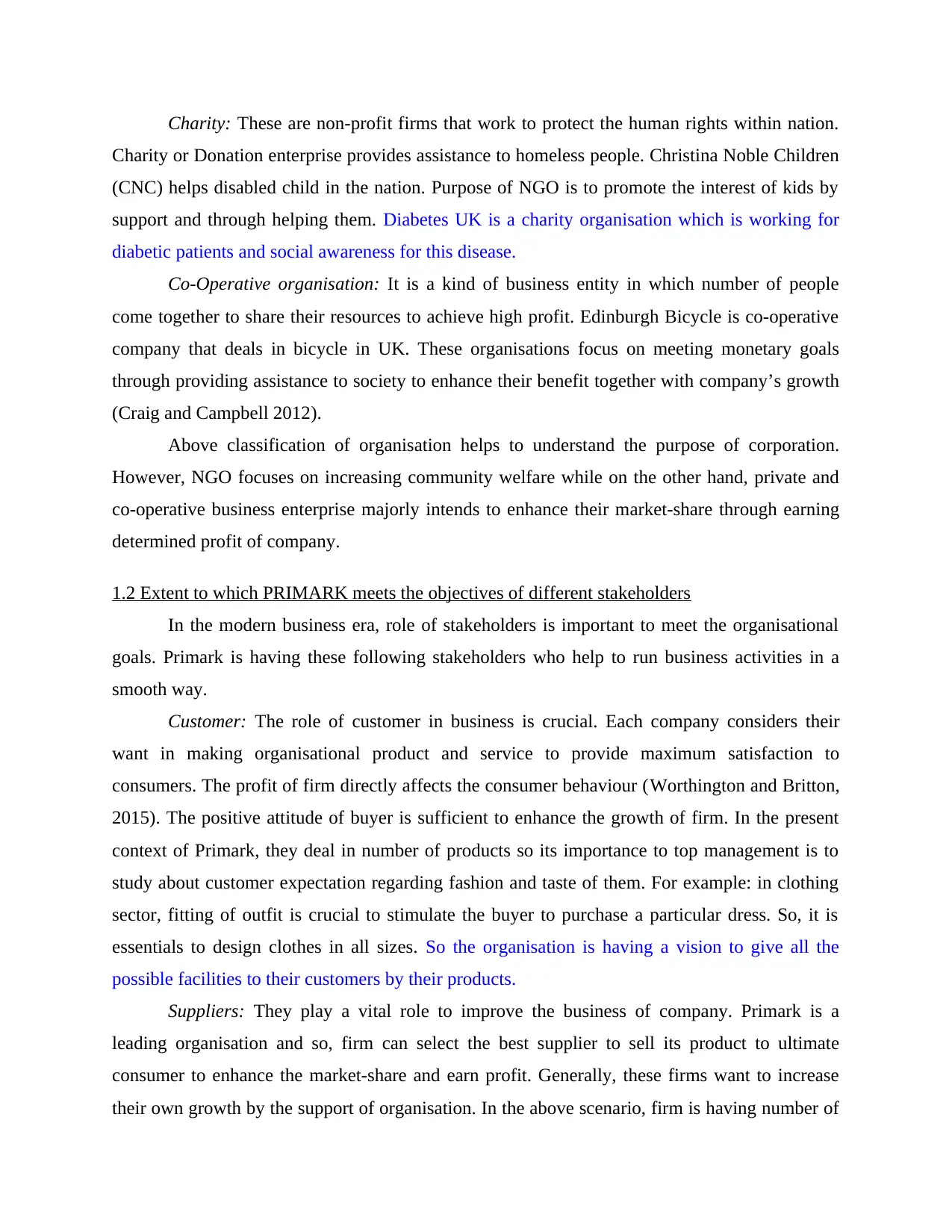
Charity: These are non-profit firms that work to protect the human rights within nation.
Charity or Donation enterprise provides assistance to homeless people. Christina Noble Children
(CNC) helps disabled child in the nation. Purpose of NGO is to promote the interest of kids by
support and through helping them. Diabetes UK is a charity organisation which is working for
diabetic patients and social awareness for this disease.
Co-Operative organisation: It is a kind of business entity in which number of people
come together to share their resources to achieve high profit. Edinburgh Bicycle is co-operative
company that deals in bicycle in UK. These organisations focus on meeting monetary goals
through providing assistance to society to enhance their benefit together with company’s growth
(Craig and Campbell 2012).
Above classification of organisation helps to understand the purpose of corporation.
However, NGO focuses on increasing community welfare while on the other hand, private and
co-operative business enterprise majorly intends to enhance their market-share through earning
determined profit of company.
1.2 Extent to which PRIMARK meets the objectives of different stakeholders
In the modern business era, role of stakeholders is important to meet the organisational
goals. Primark is having these following stakeholders who help to run business activities in a
smooth way.
Customer: The role of customer in business is crucial. Each company considers their
want in making organisational product and service to provide maximum satisfaction to
consumers. The profit of firm directly affects the consumer behaviour (Worthington and Britton,
2015). The positive attitude of buyer is sufficient to enhance the growth of firm. In the present
context of Primark, they deal in number of products so its importance to top management is to
study about customer expectation regarding fashion and taste of them. For example: in clothing
sector, fitting of outfit is crucial to stimulate the buyer to purchase a particular dress. So, it is
essentials to design clothes in all sizes. So the organisation is having a vision to give all the
possible facilities to their customers by their products.
Suppliers: They play a vital role to improve the business of company. Primark is a
leading organisation and so, firm can select the best supplier to sell its product to ultimate
consumer to enhance the market-share and earn profit. Generally, these firms want to increase
their own growth by the support of organisation. In the above scenario, firm is having number of
Charity or Donation enterprise provides assistance to homeless people. Christina Noble Children
(CNC) helps disabled child in the nation. Purpose of NGO is to promote the interest of kids by
support and through helping them. Diabetes UK is a charity organisation which is working for
diabetic patients and social awareness for this disease.
Co-Operative organisation: It is a kind of business entity in which number of people
come together to share their resources to achieve high profit. Edinburgh Bicycle is co-operative
company that deals in bicycle in UK. These organisations focus on meeting monetary goals
through providing assistance to society to enhance their benefit together with company’s growth
(Craig and Campbell 2012).
Above classification of organisation helps to understand the purpose of corporation.
However, NGO focuses on increasing community welfare while on the other hand, private and
co-operative business enterprise majorly intends to enhance their market-share through earning
determined profit of company.
1.2 Extent to which PRIMARK meets the objectives of different stakeholders
In the modern business era, role of stakeholders is important to meet the organisational
goals. Primark is having these following stakeholders who help to run business activities in a
smooth way.
Customer: The role of customer in business is crucial. Each company considers their
want in making organisational product and service to provide maximum satisfaction to
consumers. The profit of firm directly affects the consumer behaviour (Worthington and Britton,
2015). The positive attitude of buyer is sufficient to enhance the growth of firm. In the present
context of Primark, they deal in number of products so its importance to top management is to
study about customer expectation regarding fashion and taste of them. For example: in clothing
sector, fitting of outfit is crucial to stimulate the buyer to purchase a particular dress. So, it is
essentials to design clothes in all sizes. So the organisation is having a vision to give all the
possible facilities to their customers by their products.
Suppliers: They play a vital role to improve the business of company. Primark is a
leading organisation and so, firm can select the best supplier to sell its product to ultimate
consumer to enhance the market-share and earn profit. Generally, these firms want to increase
their own growth by the support of organisation. In the above scenario, firm is having number of
Paraphrase This Document
Need a fresh take? Get an instant paraphrase of this document with our AI Paraphraser
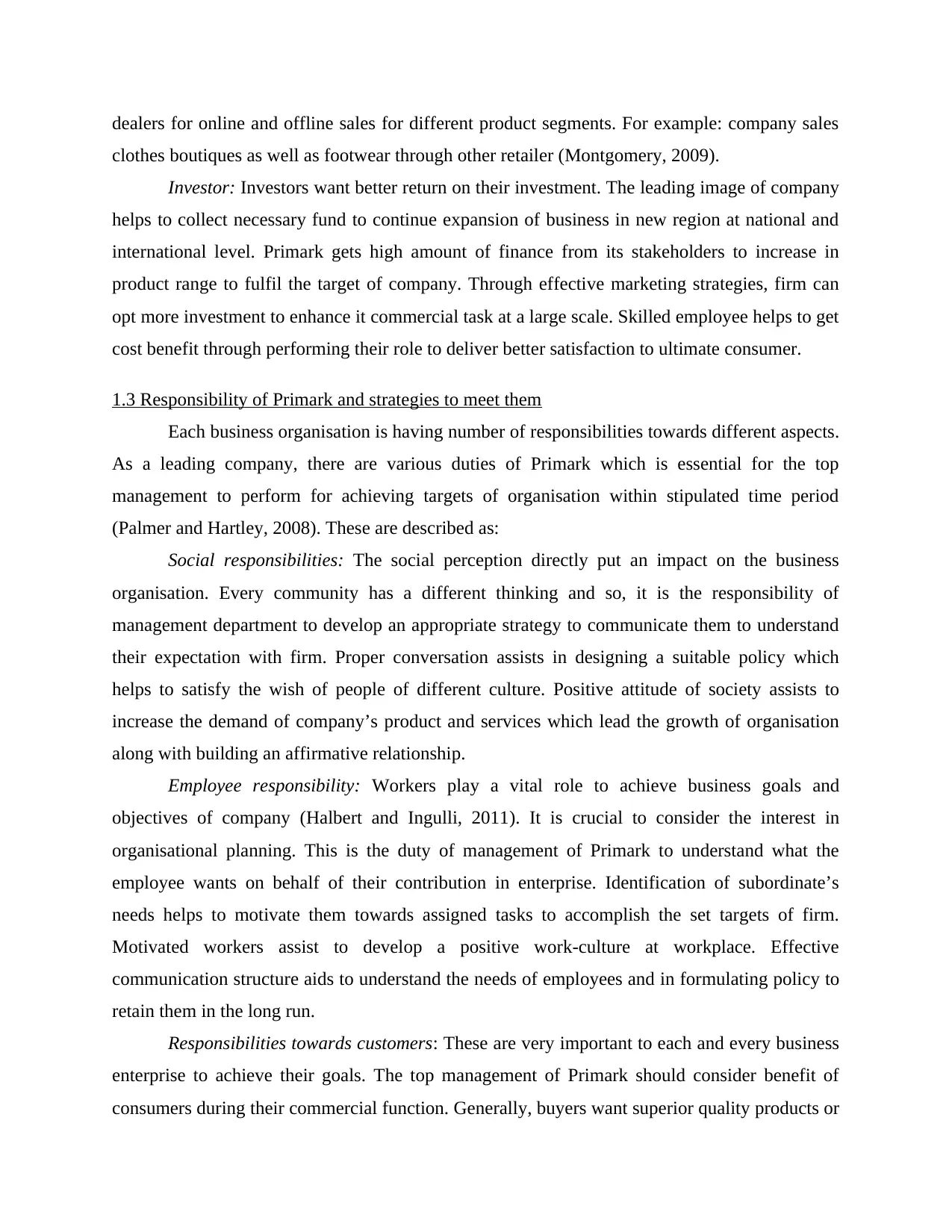
dealers for online and offline sales for different product segments. For example: company sales
clothes boutiques as well as footwear through other retailer (Montgomery, 2009).
Investor: Investors want better return on their investment. The leading image of company
helps to collect necessary fund to continue expansion of business in new region at national and
international level. Primark gets high amount of finance from its stakeholders to increase in
product range to fulfil the target of company. Through effective marketing strategies, firm can
opt more investment to enhance it commercial task at a large scale. Skilled employee helps to get
cost benefit through performing their role to deliver better satisfaction to ultimate consumer.
1.3 Responsibility of Primark and strategies to meet them
Each business organisation is having number of responsibilities towards different aspects.
As a leading company, there are various duties of Primark which is essential for the top
management to perform for achieving targets of organisation within stipulated time period
(Palmer and Hartley, 2008). These are described as:
Social responsibilities: The social perception directly put an impact on the business
organisation. Every community has a different thinking and so, it is the responsibility of
management department to develop an appropriate strategy to communicate them to understand
their expectation with firm. Proper conversation assists in designing a suitable policy which
helps to satisfy the wish of people of different culture. Positive attitude of society assists to
increase the demand of company’s product and services which lead the growth of organisation
along with building an affirmative relationship.
Employee responsibility: Workers play a vital role to achieve business goals and
objectives of company (Halbert and Ingulli, 2011). It is crucial to consider the interest in
organisational planning. This is the duty of management of Primark to understand what the
employee wants on behalf of their contribution in enterprise. Identification of subordinate’s
needs helps to motivate them towards assigned tasks to accomplish the set targets of firm.
Motivated workers assist to develop a positive work-culture at workplace. Effective
communication structure aids to understand the needs of employees and in formulating policy to
retain them in the long run.
Responsibilities towards customers: These are very important to each and every business
enterprise to achieve their goals. The top management of Primark should consider benefit of
consumers during their commercial function. Generally, buyers want superior quality products or
clothes boutiques as well as footwear through other retailer (Montgomery, 2009).
Investor: Investors want better return on their investment. The leading image of company
helps to collect necessary fund to continue expansion of business in new region at national and
international level. Primark gets high amount of finance from its stakeholders to increase in
product range to fulfil the target of company. Through effective marketing strategies, firm can
opt more investment to enhance it commercial task at a large scale. Skilled employee helps to get
cost benefit through performing their role to deliver better satisfaction to ultimate consumer.
1.3 Responsibility of Primark and strategies to meet them
Each business organisation is having number of responsibilities towards different aspects.
As a leading company, there are various duties of Primark which is essential for the top
management to perform for achieving targets of organisation within stipulated time period
(Palmer and Hartley, 2008). These are described as:
Social responsibilities: The social perception directly put an impact on the business
organisation. Every community has a different thinking and so, it is the responsibility of
management department to develop an appropriate strategy to communicate them to understand
their expectation with firm. Proper conversation assists in designing a suitable policy which
helps to satisfy the wish of people of different culture. Positive attitude of society assists to
increase the demand of company’s product and services which lead the growth of organisation
along with building an affirmative relationship.
Employee responsibility: Workers play a vital role to achieve business goals and
objectives of company (Halbert and Ingulli, 2011). It is crucial to consider the interest in
organisational planning. This is the duty of management of Primark to understand what the
employee wants on behalf of their contribution in enterprise. Identification of subordinate’s
needs helps to motivate them towards assigned tasks to accomplish the set targets of firm.
Motivated workers assist to develop a positive work-culture at workplace. Effective
communication structure aids to understand the needs of employees and in formulating policy to
retain them in the long run.
Responsibilities towards customers: These are very important to each and every business
enterprise to achieve their goals. The top management of Primark should consider benefit of
consumers during their commercial function. Generally, buyers want superior quality products or
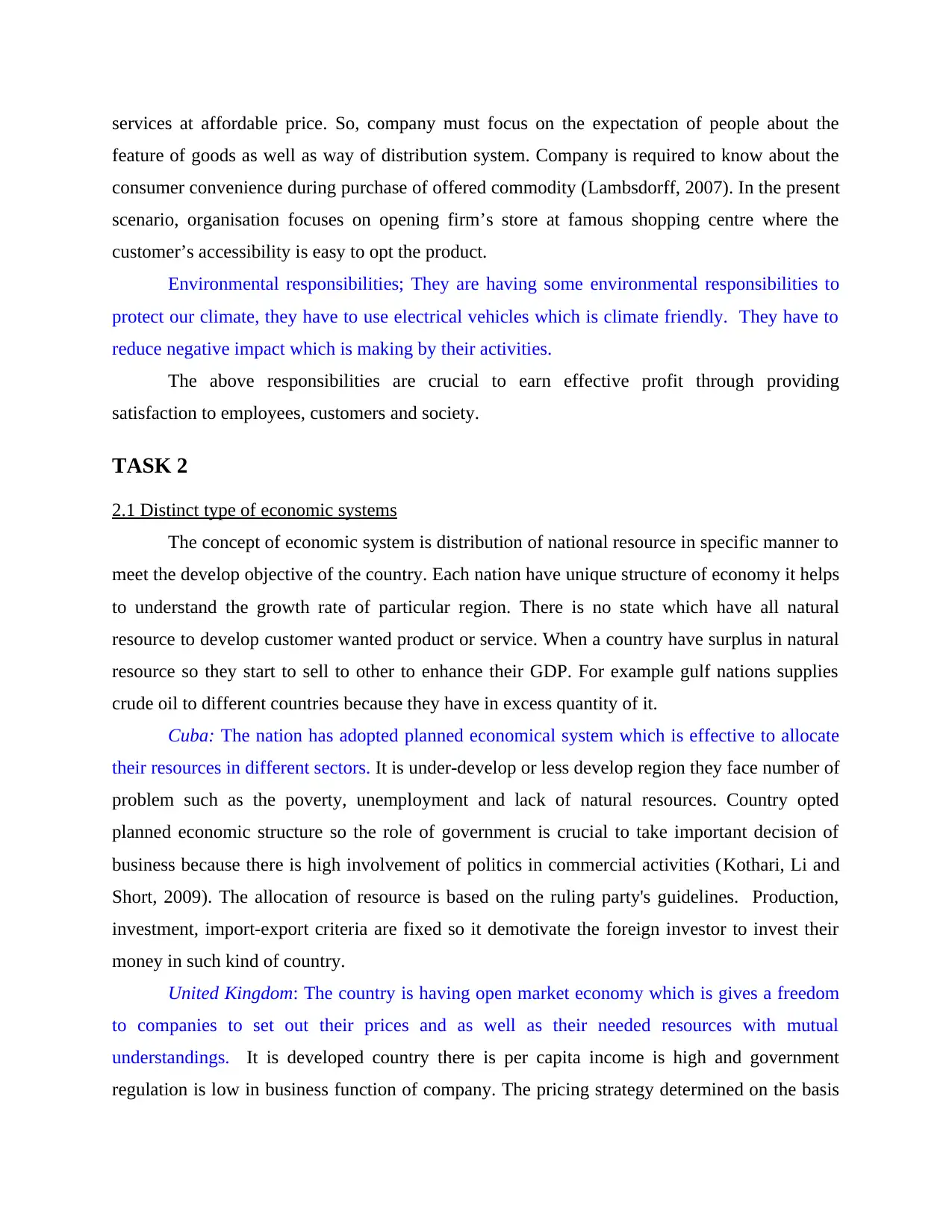
services at affordable price. So, company must focus on the expectation of people about the
feature of goods as well as way of distribution system. Company is required to know about the
consumer convenience during purchase of offered commodity (Lambsdorff, 2007). In the present
scenario, organisation focuses on opening firm’s store at famous shopping centre where the
customer’s accessibility is easy to opt the product.
Environmental responsibilities; They are having some environmental responsibilities to
protect our climate, they have to use electrical vehicles which is climate friendly. They have to
reduce negative impact which is making by their activities.
The above responsibilities are crucial to earn effective profit through providing
satisfaction to employees, customers and society.
TASK 2
2.1 Distinct type of economic systems
The concept of economic system is distribution of national resource in specific manner to
meet the develop objective of the country. Each nation have unique structure of economy it helps
to understand the growth rate of particular region. There is no state which have all natural
resource to develop customer wanted product or service. When a country have surplus in natural
resource so they start to sell to other to enhance their GDP. For example gulf nations supplies
crude oil to different countries because they have in excess quantity of it.
Cuba: The nation has adopted planned economical system which is effective to allocate
their resources in different sectors. It is under-develop or less develop region they face number of
problem such as the poverty, unemployment and lack of natural resources. Country opted
planned economic structure so the role of government is crucial to take important decision of
business because there is high involvement of politics in commercial activities (Kothari, Li and
Short, 2009). The allocation of resource is based on the ruling party's guidelines. Production,
investment, import-export criteria are fixed so it demotivate the foreign investor to invest their
money in such kind of country.
United Kingdom: The country is having open market economy which is gives a freedom
to companies to set out their prices and as well as their needed resources with mutual
understandings. It is developed country there is per capita income is high and government
regulation is low in business function of company. The pricing strategy determined on the basis
feature of goods as well as way of distribution system. Company is required to know about the
consumer convenience during purchase of offered commodity (Lambsdorff, 2007). In the present
scenario, organisation focuses on opening firm’s store at famous shopping centre where the
customer’s accessibility is easy to opt the product.
Environmental responsibilities; They are having some environmental responsibilities to
protect our climate, they have to use electrical vehicles which is climate friendly. They have to
reduce negative impact which is making by their activities.
The above responsibilities are crucial to earn effective profit through providing
satisfaction to employees, customers and society.
TASK 2
2.1 Distinct type of economic systems
The concept of economic system is distribution of national resource in specific manner to
meet the develop objective of the country. Each nation have unique structure of economy it helps
to understand the growth rate of particular region. There is no state which have all natural
resource to develop customer wanted product or service. When a country have surplus in natural
resource so they start to sell to other to enhance their GDP. For example gulf nations supplies
crude oil to different countries because they have in excess quantity of it.
Cuba: The nation has adopted planned economical system which is effective to allocate
their resources in different sectors. It is under-develop or less develop region they face number of
problem such as the poverty, unemployment and lack of natural resources. Country opted
planned economic structure so the role of government is crucial to take important decision of
business because there is high involvement of politics in commercial activities (Kothari, Li and
Short, 2009). The allocation of resource is based on the ruling party's guidelines. Production,
investment, import-export criteria are fixed so it demotivate the foreign investor to invest their
money in such kind of country.
United Kingdom: The country is having open market economy which is gives a freedom
to companies to set out their prices and as well as their needed resources with mutual
understandings. It is developed country there is per capita income is high and government
regulation is low in business function of company. The pricing strategy determined on the basis
⊘ This is a preview!⊘
Do you want full access?
Subscribe today to unlock all pages.

Trusted by 1+ million students worldwide
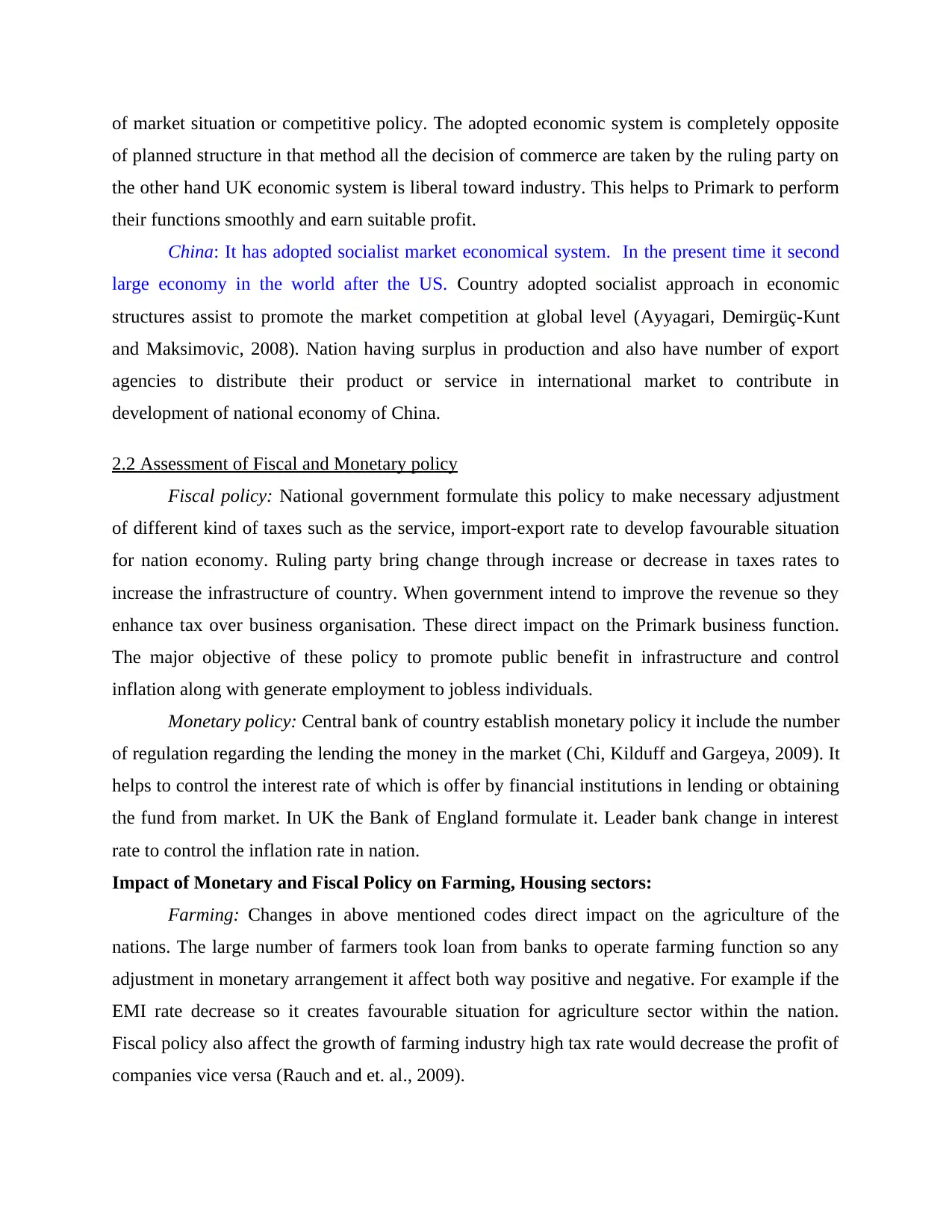
of market situation or competitive policy. The adopted economic system is completely opposite
of planned structure in that method all the decision of commerce are taken by the ruling party on
the other hand UK economic system is liberal toward industry. This helps to Primark to perform
their functions smoothly and earn suitable profit.
China: It has adopted socialist market economical system. In the present time it second
large economy in the world after the US. Country adopted socialist approach in economic
structures assist to promote the market competition at global level (Ayyagari, Demirgüç-Kunt
and Maksimovic, 2008). Nation having surplus in production and also have number of export
agencies to distribute their product or service in international market to contribute in
development of national economy of China.
2.2 Assessment of Fiscal and Monetary policy
Fiscal policy: National government formulate this policy to make necessary adjustment
of different kind of taxes such as the service, import-export rate to develop favourable situation
for nation economy. Ruling party bring change through increase or decrease in taxes rates to
increase the infrastructure of country. When government intend to improve the revenue so they
enhance tax over business organisation. These direct impact on the Primark business function.
The major objective of these policy to promote public benefit in infrastructure and control
inflation along with generate employment to jobless individuals.
Monetary policy: Central bank of country establish monetary policy it include the number
of regulation regarding the lending the money in the market (Chi, Kilduff and Gargeya, 2009). It
helps to control the interest rate of which is offer by financial institutions in lending or obtaining
the fund from market. In UK the Bank of England formulate it. Leader bank change in interest
rate to control the inflation rate in nation.
Impact of Monetary and Fiscal Policy on Farming, Housing sectors:
Farming: Changes in above mentioned codes direct impact on the agriculture of the
nations. The large number of farmers took loan from banks to operate farming function so any
adjustment in monetary arrangement it affect both way positive and negative. For example if the
EMI rate decrease so it creates favourable situation for agriculture sector within the nation.
Fiscal policy also affect the growth of farming industry high tax rate would decrease the profit of
companies vice versa (Rauch and et. al., 2009).
of planned structure in that method all the decision of commerce are taken by the ruling party on
the other hand UK economic system is liberal toward industry. This helps to Primark to perform
their functions smoothly and earn suitable profit.
China: It has adopted socialist market economical system. In the present time it second
large economy in the world after the US. Country adopted socialist approach in economic
structures assist to promote the market competition at global level (Ayyagari, Demirgüç-Kunt
and Maksimovic, 2008). Nation having surplus in production and also have number of export
agencies to distribute their product or service in international market to contribute in
development of national economy of China.
2.2 Assessment of Fiscal and Monetary policy
Fiscal policy: National government formulate this policy to make necessary adjustment
of different kind of taxes such as the service, import-export rate to develop favourable situation
for nation economy. Ruling party bring change through increase or decrease in taxes rates to
increase the infrastructure of country. When government intend to improve the revenue so they
enhance tax over business organisation. These direct impact on the Primark business function.
The major objective of these policy to promote public benefit in infrastructure and control
inflation along with generate employment to jobless individuals.
Monetary policy: Central bank of country establish monetary policy it include the number
of regulation regarding the lending the money in the market (Chi, Kilduff and Gargeya, 2009). It
helps to control the interest rate of which is offer by financial institutions in lending or obtaining
the fund from market. In UK the Bank of England formulate it. Leader bank change in interest
rate to control the inflation rate in nation.
Impact of Monetary and Fiscal Policy on Farming, Housing sectors:
Farming: Changes in above mentioned codes direct impact on the agriculture of the
nations. The large number of farmers took loan from banks to operate farming function so any
adjustment in monetary arrangement it affect both way positive and negative. For example if the
EMI rate decrease so it creates favourable situation for agriculture sector within the nation.
Fiscal policy also affect the growth of farming industry high tax rate would decrease the profit of
companies vice versa (Rauch and et. al., 2009).
Paraphrase This Document
Need a fresh take? Get an instant paraphrase of this document with our AI Paraphraser
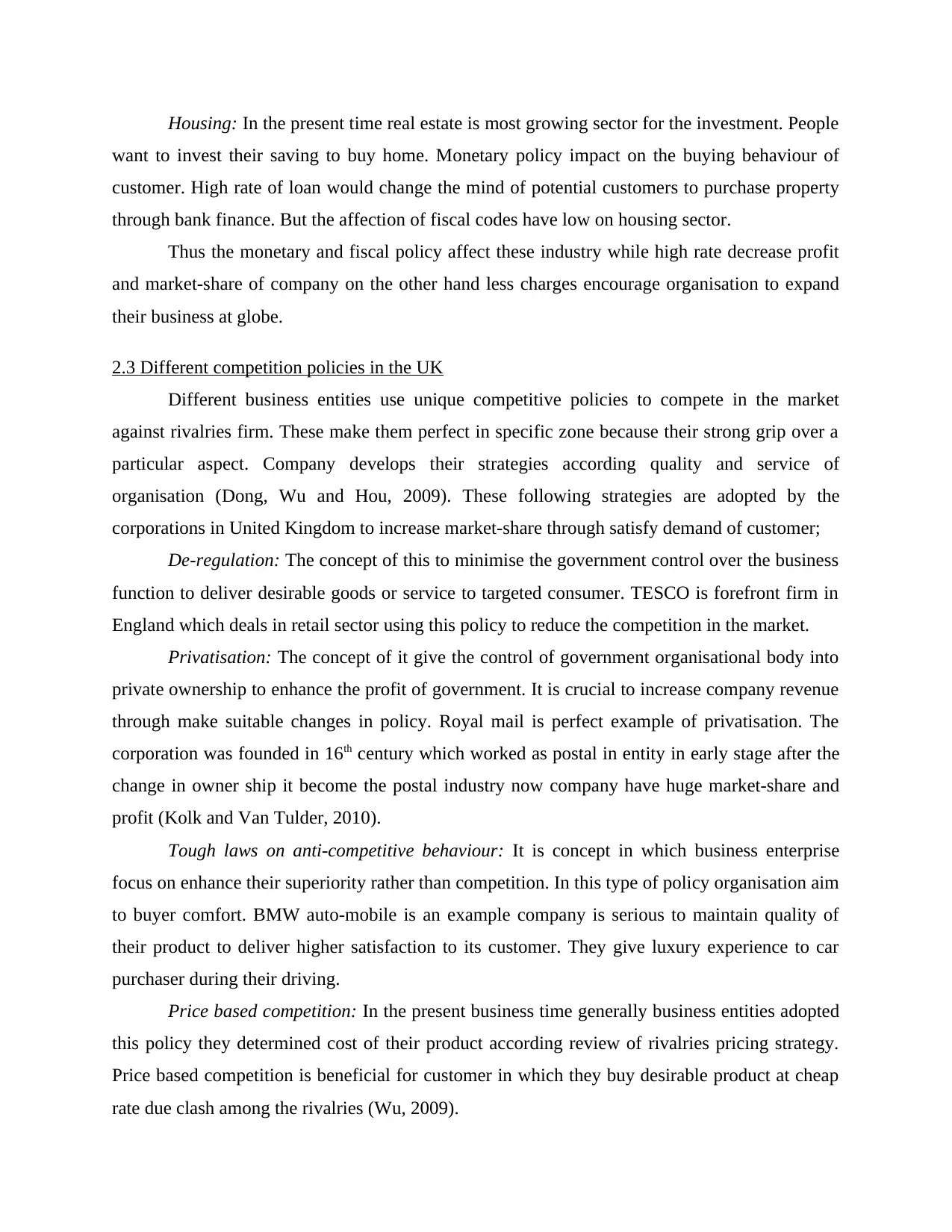
Housing: In the present time real estate is most growing sector for the investment. People
want to invest their saving to buy home. Monetary policy impact on the buying behaviour of
customer. High rate of loan would change the mind of potential customers to purchase property
through bank finance. But the affection of fiscal codes have low on housing sector.
Thus the monetary and fiscal policy affect these industry while high rate decrease profit
and market-share of company on the other hand less charges encourage organisation to expand
their business at globe.
2.3 Different competition policies in the UK
Different business entities use unique competitive policies to compete in the market
against rivalries firm. These make them perfect in specific zone because their strong grip over a
particular aspect. Company develops their strategies according quality and service of
organisation (Dong, Wu and Hou, 2009). These following strategies are adopted by the
corporations in United Kingdom to increase market-share through satisfy demand of customer;
De-regulation: The concept of this to minimise the government control over the business
function to deliver desirable goods or service to targeted consumer. TESCO is forefront firm in
England which deals in retail sector using this policy to reduce the competition in the market.
Privatisation: The concept of it give the control of government organisational body into
private ownership to enhance the profit of government. It is crucial to increase company revenue
through make suitable changes in policy. Royal mail is perfect example of privatisation. The
corporation was founded in 16th century which worked as postal in entity in early stage after the
change in owner ship it become the postal industry now company have huge market-share and
profit (Kolk and Van Tulder, 2010).
Tough laws on anti-competitive behaviour: It is concept in which business enterprise
focus on enhance their superiority rather than competition. In this type of policy organisation aim
to buyer comfort. BMW auto-mobile is an example company is serious to maintain quality of
their product to deliver higher satisfaction to its customer. They give luxury experience to car
purchaser during their driving.
Price based competition: In the present business time generally business entities adopted
this policy they determined cost of their product according review of rivalries pricing strategy.
Price based competition is beneficial for customer in which they buy desirable product at cheap
rate due clash among the rivalries (Wu, 2009).
want to invest their saving to buy home. Monetary policy impact on the buying behaviour of
customer. High rate of loan would change the mind of potential customers to purchase property
through bank finance. But the affection of fiscal codes have low on housing sector.
Thus the monetary and fiscal policy affect these industry while high rate decrease profit
and market-share of company on the other hand less charges encourage organisation to expand
their business at globe.
2.3 Different competition policies in the UK
Different business entities use unique competitive policies to compete in the market
against rivalries firm. These make them perfect in specific zone because their strong grip over a
particular aspect. Company develops their strategies according quality and service of
organisation (Dong, Wu and Hou, 2009). These following strategies are adopted by the
corporations in United Kingdom to increase market-share through satisfy demand of customer;
De-regulation: The concept of this to minimise the government control over the business
function to deliver desirable goods or service to targeted consumer. TESCO is forefront firm in
England which deals in retail sector using this policy to reduce the competition in the market.
Privatisation: The concept of it give the control of government organisational body into
private ownership to enhance the profit of government. It is crucial to increase company revenue
through make suitable changes in policy. Royal mail is perfect example of privatisation. The
corporation was founded in 16th century which worked as postal in entity in early stage after the
change in owner ship it become the postal industry now company have huge market-share and
profit (Kolk and Van Tulder, 2010).
Tough laws on anti-competitive behaviour: It is concept in which business enterprise
focus on enhance their superiority rather than competition. In this type of policy organisation aim
to buyer comfort. BMW auto-mobile is an example company is serious to maintain quality of
their product to deliver higher satisfaction to its customer. They give luxury experience to car
purchaser during their driving.
Price based competition: In the present business time generally business entities adopted
this policy they determined cost of their product according review of rivalries pricing strategy.
Price based competition is beneficial for customer in which they buy desirable product at cheap
rate due clash among the rivalries (Wu, 2009).
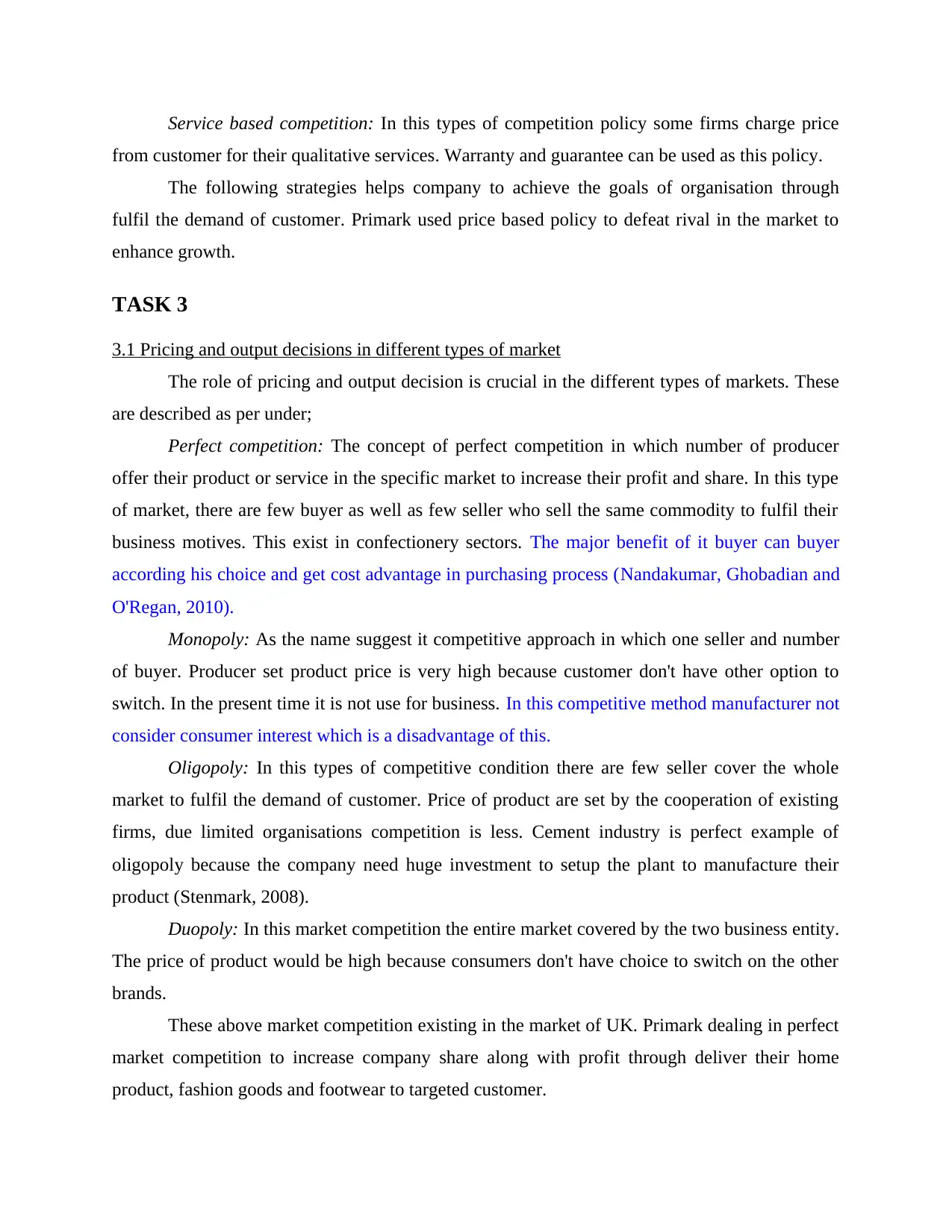
Service based competition: In this types of competition policy some firms charge price
from customer for their qualitative services. Warranty and guarantee can be used as this policy.
The following strategies helps company to achieve the goals of organisation through
fulfil the demand of customer. Primark used price based policy to defeat rival in the market to
enhance growth.
TASK 3
3.1 Pricing and output decisions in different types of market
The role of pricing and output decision is crucial in the different types of markets. These
are described as per under;
Perfect competition: The concept of perfect competition in which number of producer
offer their product or service in the specific market to increase their profit and share. In this type
of market, there are few buyer as well as few seller who sell the same commodity to fulfil their
business motives. This exist in confectionery sectors. The major benefit of it buyer can buyer
according his choice and get cost advantage in purchasing process (Nandakumar, Ghobadian and
O'Regan, 2010).
Monopoly: As the name suggest it competitive approach in which one seller and number
of buyer. Producer set product price is very high because customer don't have other option to
switch. In the present time it is not use for business. In this competitive method manufacturer not
consider consumer interest which is a disadvantage of this.
Oligopoly: In this types of competitive condition there are few seller cover the whole
market to fulfil the demand of customer. Price of product are set by the cooperation of existing
firms, due limited organisations competition is less. Cement industry is perfect example of
oligopoly because the company need huge investment to setup the plant to manufacture their
product (Stenmark, 2008).
Duopoly: In this market competition the entire market covered by the two business entity.
The price of product would be high because consumers don't have choice to switch on the other
brands.
These above market competition existing in the market of UK. Primark dealing in perfect
market competition to increase company share along with profit through deliver their home
product, fashion goods and footwear to targeted customer.
from customer for their qualitative services. Warranty and guarantee can be used as this policy.
The following strategies helps company to achieve the goals of organisation through
fulfil the demand of customer. Primark used price based policy to defeat rival in the market to
enhance growth.
TASK 3
3.1 Pricing and output decisions in different types of market
The role of pricing and output decision is crucial in the different types of markets. These
are described as per under;
Perfect competition: The concept of perfect competition in which number of producer
offer their product or service in the specific market to increase their profit and share. In this type
of market, there are few buyer as well as few seller who sell the same commodity to fulfil their
business motives. This exist in confectionery sectors. The major benefit of it buyer can buyer
according his choice and get cost advantage in purchasing process (Nandakumar, Ghobadian and
O'Regan, 2010).
Monopoly: As the name suggest it competitive approach in which one seller and number
of buyer. Producer set product price is very high because customer don't have other option to
switch. In the present time it is not use for business. In this competitive method manufacturer not
consider consumer interest which is a disadvantage of this.
Oligopoly: In this types of competitive condition there are few seller cover the whole
market to fulfil the demand of customer. Price of product are set by the cooperation of existing
firms, due limited organisations competition is less. Cement industry is perfect example of
oligopoly because the company need huge investment to setup the plant to manufacture their
product (Stenmark, 2008).
Duopoly: In this market competition the entire market covered by the two business entity.
The price of product would be high because consumers don't have choice to switch on the other
brands.
These above market competition existing in the market of UK. Primark dealing in perfect
market competition to increase company share along with profit through deliver their home
product, fashion goods and footwear to targeted customer.
⊘ This is a preview!⊘
Do you want full access?
Subscribe today to unlock all pages.

Trusted by 1+ million students worldwide

3.2 Impact of market forces on organisation
Business growth directly affect by the market forces. To reduce the negative impact of it
top management must make suitable adjustment in planning and strategies of company.
Elasticity of demand is major factor which create pressure on operational function of every
business enterprises. Demand can be defined as the requirement of any product or service from
consumer side while the supply reflect the delivery of particular goods in the market to satisfy
their need (Moe and Trusov, 2011). In the present context of Primark is growing retailer in UK
to sell their products through different types of vendors to ultimate users. Demand and supply
directly impact on the business function of the company. Higher want forced to organisation to
increase their supply to fulfil consumer wish. Price affect the demand of product or service.
Lower cost of commodity increase requirement along with it enhance the supply of commodity
of company. The demand curve would be downward because the higher price decline the
demand of product of the company. On the other hand, high supply of product shows increasing
need of goods in the market and the demand curve would be upward. These helps to organisation
to captured large market-share through providing commodity in bulk quantity. The below
diagram assist to understand the relationship of demand and supply of product.
(Source: Demand and supply, 2016)
Illustration 1: DEMAND AND SUPPLY
Business growth directly affect by the market forces. To reduce the negative impact of it
top management must make suitable adjustment in planning and strategies of company.
Elasticity of demand is major factor which create pressure on operational function of every
business enterprises. Demand can be defined as the requirement of any product or service from
consumer side while the supply reflect the delivery of particular goods in the market to satisfy
their need (Moe and Trusov, 2011). In the present context of Primark is growing retailer in UK
to sell their products through different types of vendors to ultimate users. Demand and supply
directly impact on the business function of the company. Higher want forced to organisation to
increase their supply to fulfil consumer wish. Price affect the demand of product or service.
Lower cost of commodity increase requirement along with it enhance the supply of commodity
of company. The demand curve would be downward because the higher price decline the
demand of product of the company. On the other hand, high supply of product shows increasing
need of goods in the market and the demand curve would be upward. These helps to organisation
to captured large market-share through providing commodity in bulk quantity. The below
diagram assist to understand the relationship of demand and supply of product.
(Source: Demand and supply, 2016)
Illustration 1: DEMAND AND SUPPLY
Paraphrase This Document
Need a fresh take? Get an instant paraphrase of this document with our AI Paraphraser
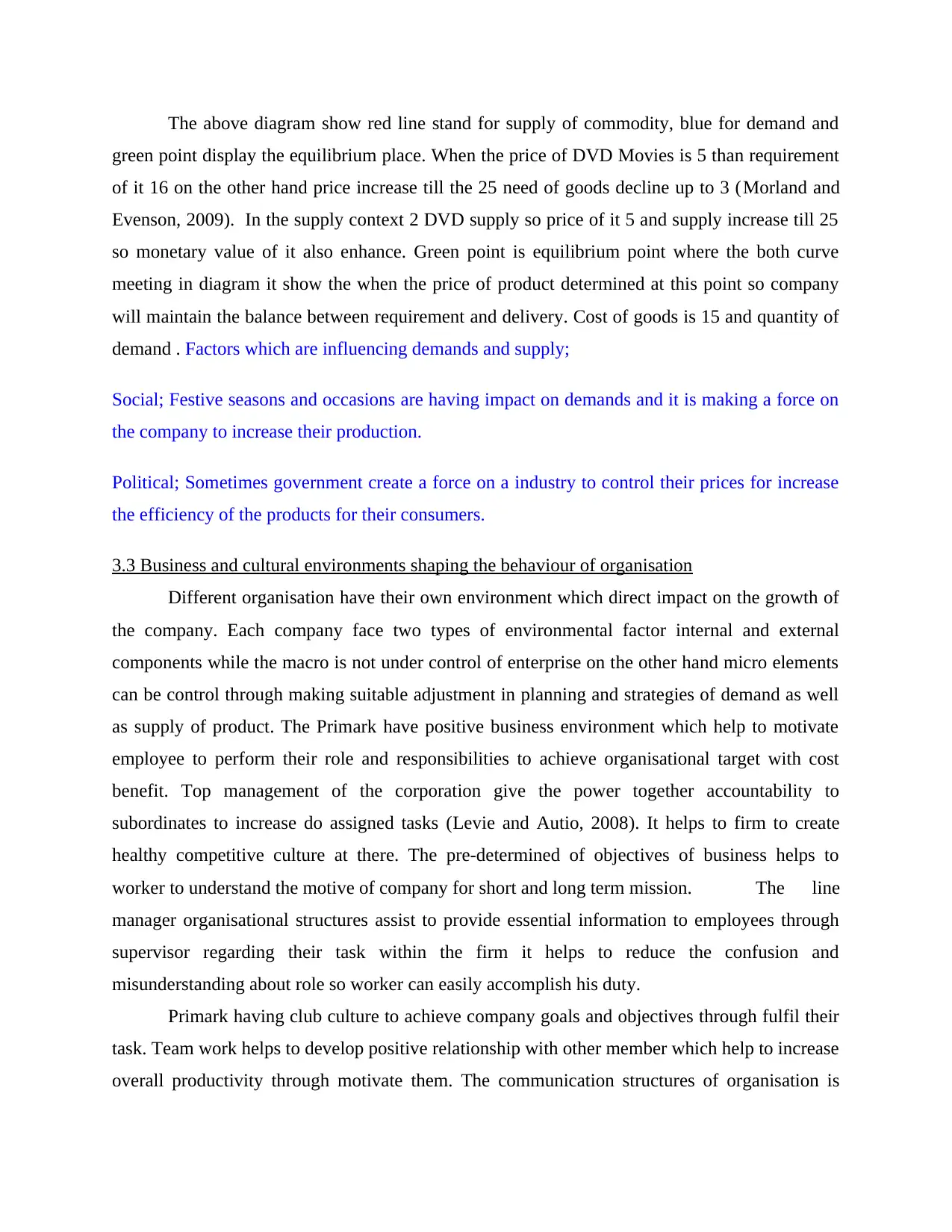
The above diagram show red line stand for supply of commodity, blue for demand and
green point display the equilibrium place. When the price of DVD Movies is 5 than requirement
of it 16 on the other hand price increase till the 25 need of goods decline up to 3 (Morland and
Evenson, 2009). In the supply context 2 DVD supply so price of it 5 and supply increase till 25
so monetary value of it also enhance. Green point is equilibrium point where the both curve
meeting in diagram it show the when the price of product determined at this point so company
will maintain the balance between requirement and delivery. Cost of goods is 15 and quantity of
demand . Factors which are influencing demands and supply;
Social; Festive seasons and occasions are having impact on demands and it is making a force on
the company to increase their production.
Political; Sometimes government create a force on a industry to control their prices for increase
the efficiency of the products for their consumers.
3.3 Business and cultural environments shaping the behaviour of organisation
Different organisation have their own environment which direct impact on the growth of
the company. Each company face two types of environmental factor internal and external
components while the macro is not under control of enterprise on the other hand micro elements
can be control through making suitable adjustment in planning and strategies of demand as well
as supply of product. The Primark have positive business environment which help to motivate
employee to perform their role and responsibilities to achieve organisational target with cost
benefit. Top management of the corporation give the power together accountability to
subordinates to increase do assigned tasks (Levie and Autio, 2008). It helps to firm to create
healthy competitive culture at there. The pre-determined of objectives of business helps to
worker to understand the motive of company for short and long term mission. The line
manager organisational structures assist to provide essential information to employees through
supervisor regarding their task within the firm it helps to reduce the confusion and
misunderstanding about role so worker can easily accomplish his duty.
Primark having club culture to achieve company goals and objectives through fulfil their
task. Team work helps to develop positive relationship with other member which help to increase
overall productivity through motivate them. The communication structures of organisation is
green point display the equilibrium place. When the price of DVD Movies is 5 than requirement
of it 16 on the other hand price increase till the 25 need of goods decline up to 3 (Morland and
Evenson, 2009). In the supply context 2 DVD supply so price of it 5 and supply increase till 25
so monetary value of it also enhance. Green point is equilibrium point where the both curve
meeting in diagram it show the when the price of product determined at this point so company
will maintain the balance between requirement and delivery. Cost of goods is 15 and quantity of
demand . Factors which are influencing demands and supply;
Social; Festive seasons and occasions are having impact on demands and it is making a force on
the company to increase their production.
Political; Sometimes government create a force on a industry to control their prices for increase
the efficiency of the products for their consumers.
3.3 Business and cultural environments shaping the behaviour of organisation
Different organisation have their own environment which direct impact on the growth of
the company. Each company face two types of environmental factor internal and external
components while the macro is not under control of enterprise on the other hand micro elements
can be control through making suitable adjustment in planning and strategies of demand as well
as supply of product. The Primark have positive business environment which help to motivate
employee to perform their role and responsibilities to achieve organisational target with cost
benefit. Top management of the corporation give the power together accountability to
subordinates to increase do assigned tasks (Levie and Autio, 2008). It helps to firm to create
healthy competitive culture at there. The pre-determined of objectives of business helps to
worker to understand the motive of company for short and long term mission. The line
manager organisational structures assist to provide essential information to employees through
supervisor regarding their task within the firm it helps to reduce the confusion and
misunderstanding about role so worker can easily accomplish his duty.
Primark having club culture to achieve company goals and objectives through fulfil their
task. Team work helps to develop positive relationship with other member which help to increase
overall productivity through motivate them. The communication structures of organisation is
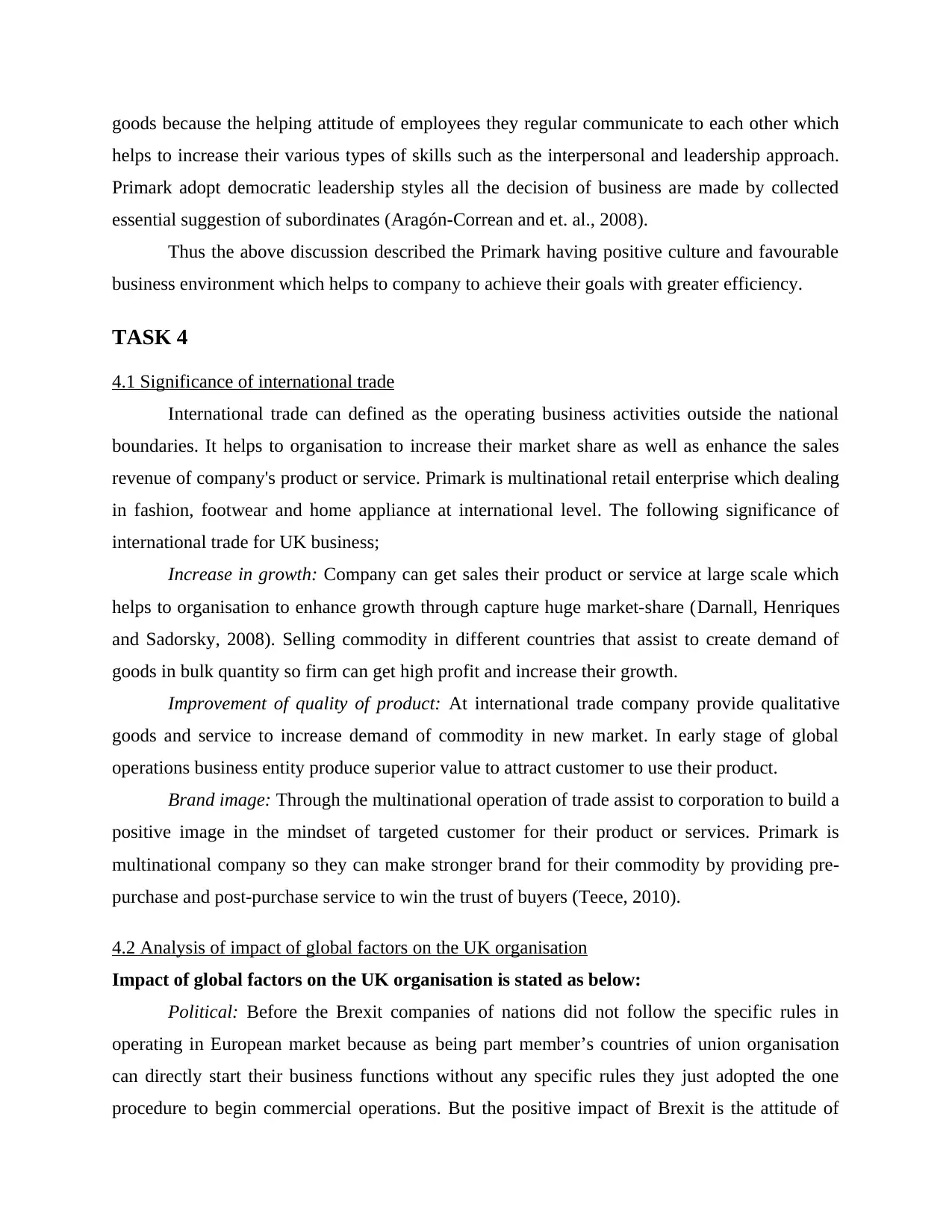
goods because the helping attitude of employees they regular communicate to each other which
helps to increase their various types of skills such as the interpersonal and leadership approach.
Primark adopt democratic leadership styles all the decision of business are made by collected
essential suggestion of subordinates (Aragón-Correan and et. al., 2008).
Thus the above discussion described the Primark having positive culture and favourable
business environment which helps to company to achieve their goals with greater efficiency.
TASK 4
4.1 Significance of international trade
International trade can defined as the operating business activities outside the national
boundaries. It helps to organisation to increase their market share as well as enhance the sales
revenue of company's product or service. Primark is multinational retail enterprise which dealing
in fashion, footwear and home appliance at international level. The following significance of
international trade for UK business;
Increase in growth: Company can get sales their product or service at large scale which
helps to organisation to enhance growth through capture huge market-share (Darnall, Henriques
and Sadorsky, 2008). Selling commodity in different countries that assist to create demand of
goods in bulk quantity so firm can get high profit and increase their growth.
Improvement of quality of product: At international trade company provide qualitative
goods and service to increase demand of commodity in new market. In early stage of global
operations business entity produce superior value to attract customer to use their product.
Brand image: Through the multinational operation of trade assist to corporation to build a
positive image in the mindset of targeted customer for their product or services. Primark is
multinational company so they can make stronger brand for their commodity by providing pre-
purchase and post-purchase service to win the trust of buyers (Teece, 2010).
4.2 Analysis of impact of global factors on the UK organisation
Impact of global factors on the UK organisation is stated as below:
Political: Before the Brexit companies of nations did not follow the specific rules in
operating in European market because as being part member’s countries of union organisation
can directly start their business functions without any specific rules they just adopted the one
procedure to begin commercial operations. But the positive impact of Brexit is the attitude of
helps to increase their various types of skills such as the interpersonal and leadership approach.
Primark adopt democratic leadership styles all the decision of business are made by collected
essential suggestion of subordinates (Aragón-Correan and et. al., 2008).
Thus the above discussion described the Primark having positive culture and favourable
business environment which helps to company to achieve their goals with greater efficiency.
TASK 4
4.1 Significance of international trade
International trade can defined as the operating business activities outside the national
boundaries. It helps to organisation to increase their market share as well as enhance the sales
revenue of company's product or service. Primark is multinational retail enterprise which dealing
in fashion, footwear and home appliance at international level. The following significance of
international trade for UK business;
Increase in growth: Company can get sales their product or service at large scale which
helps to organisation to enhance growth through capture huge market-share (Darnall, Henriques
and Sadorsky, 2008). Selling commodity in different countries that assist to create demand of
goods in bulk quantity so firm can get high profit and increase their growth.
Improvement of quality of product: At international trade company provide qualitative
goods and service to increase demand of commodity in new market. In early stage of global
operations business entity produce superior value to attract customer to use their product.
Brand image: Through the multinational operation of trade assist to corporation to build a
positive image in the mindset of targeted customer for their product or services. Primark is
multinational company so they can make stronger brand for their commodity by providing pre-
purchase and post-purchase service to win the trust of buyers (Teece, 2010).
4.2 Analysis of impact of global factors on the UK organisation
Impact of global factors on the UK organisation is stated as below:
Political: Before the Brexit companies of nations did not follow the specific rules in
operating in European market because as being part member’s countries of union organisation
can directly start their business functions without any specific rules they just adopted the one
procedure to begin commercial operations. But the positive impact of Brexit is the attitude of
⊘ This is a preview!⊘
Do you want full access?
Subscribe today to unlock all pages.

Trusted by 1+ million students worldwide
1 out of 18
Related Documents
Your All-in-One AI-Powered Toolkit for Academic Success.
+13062052269
info@desklib.com
Available 24*7 on WhatsApp / Email
![[object Object]](/_next/static/media/star-bottom.7253800d.svg)
Unlock your academic potential
Copyright © 2020–2025 A2Z Services. All Rights Reserved. Developed and managed by ZUCOL.





